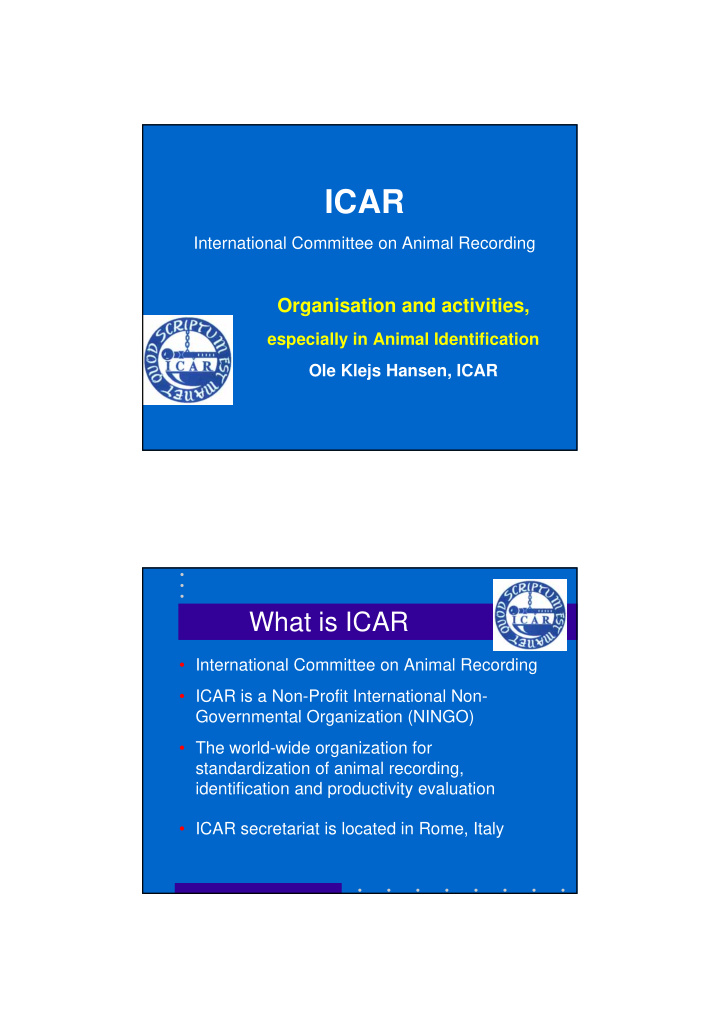



ICAR International Committee on Animal Recording Organisation and activities, especially in Animal Identification Ole Klejs Hansen, ICAR What is ICAR • International Committee on Animal Recording • ICAR is a Non-Profit International Non- Governmental Organization (NINGO) • The world-wide organization for standardization of animal recording, identification and productivity evaluation • ICAR secretariat is located in Rome, Italy
Missions of ICAR (1) • Providing: – Definitions and standards for measurement of traits of economic importance – Information and services to help member organizations to develop, operate and manage their business – Information and services which promote benefits of recording and evaluation, thereby increasing the demand for the services provided by ICAR member organizations Missions of ICAR (2) • Providing: – Guidelines which facilitate the provision of services – Standards facilitating the exchange of information by member organizations both nationally and internationally – Body through which member organizations can work together to achieve shared objectives
ICAR History (1) • First dairy performance recordings in USA (1883 for Holstein cattle) • First routine milk recording in Denmark (1895) • Early attempt to internationally standardize milk recording (Paris meeting, 1923) • European Milk/Butter Recording Committee (Rome, 1951) ICAR History (2) • Introduced the milkability (1963) • The first attempt to introduce computerized systems in the early 60s • Starting testing precision of recording devices for milk recording (1968) • Other types of animal production recording introduced (Beef cattle, 1982)
ICAR History (3) • Interbull became operative (1988) • Early 90s ICAR began working on other species, such as sheep, goats and dairy buffalo • Early 90s ISO and ICAR started developing standards for RFID and approval system for RFID devices to be used for animal identification ICAR Today • 68 full member organizations from 45 countries • 7 associate members (manufacturers etc.) • ICAR does technical activities and developments through 4 sub-committees, 9 working groups and 6 task forces • About 100 technicians work voluntarily to fulfil ICAR missions
ICAR Work Structure ICAR Board Subcommittees Working Groups Task Forces • Animal Recording Data • Animal Fibre • Artificial Insemination & • Animal Identification • Developing Relevant Technologies Countries • Beef Performance • Interbull • Conformance Recording • Interbeef • Genetic Analysis • Milk Recording • Milk Analysis • Functional Traits Practices • Lactation Calculation • Parentage • Recording Devices Methods Recording • Milk Recording in Goats • Pig Recording • Milk Recording in Sheep ICAR Sub-Committees • Interbull – Calculating routine international genetic evaluations for cattle. Over 25 countries currently subscribe to this service. – Meetings, workshops, surveys, presentations and publications. – Developing methods for generating international genetic evaluations. – Advice and assistance relating to the genetic evaluation of cattle.
ICAR Sub-Committees • Recording devices –Minimum requirements for accuracy of recording devices –Test and approve recording devices –Guidelines for maintenance and accuracy of recording devices ICAR Sub-Committees • Animal Identification – Develop international standards of identification systems – Test and approve identification devices – Registration of manufacturers and approved identification devices
Subcommittee Members • Members proposed by member organisations • Mostly animal husbandry specialists working with I&R • How can a hand full of such people set standards ?? • External technical expertise Members, subcommittee • Current members come from: – USA, Australia, France, Germany, UK, Denmark • International standards require global wiev • Looking for members also from other parts of the world: – Asia, South America, Africa – Development countries
External expertise • Electronic identification devices: • Participation in ISO Working Groups on EID • Experts from ICAR approved test centres • Plastic tags: • Experience from national test programmes • Especially inspired by French test programme • Experts from ICAR approved test centres The process • ICAR SC observes agricultural and industry aspects of interest • ICAR SC builds in cooperation with experts and industry proposals for ICAR test protocol and approval systems • ICAR General Assembly approves SC proposals. • Decision of Full ICAR members
Test EID devices Test Kind of test category Performance Application-/Field test (for any kind/combination of identification devices) Extended laboratory test (for any kind/combination of identification devices) Laboratory test (predominant) Conformity Transponder Other ID-devices conformity Reader conformity conformity (with granting of manufacturer code) Tested devices so far Eartag Bolus Inject 53 35 81
www.icar.org New design of webpage • More than 170 products • More than 75 manufacturers • All in one predefined list • New webpage with all products • Sort and search facilities • User friendly
ICAR relations in RFID – ISO and ICAR advising EU Commission about guidelines and approvals of RFID devices for sheep and goats – Contacts to US and Canada authorities and organisations about ID devices – ICAR in contact with OIE (World Organisation for Animal Health) – Make activities of ICAR within animal ID and traceability known by authorities ICAR participation – FAO, OIE and ICAR workshop on Animal ID and traceability with 18 countries from South East Asia (July 2007, Sri Lanka) – FAO and ICAR workshop on Development of animal identification and recording systems for veterinary surveillance and livestock development in countries of Central and Eastern Europe
The aim of ICAR • To provide test and approval of ID- devices to benefit users worldwide • Users are animal keepers, service providers and authorities • ICAR’s tests and approvals should be at a level of very high acceptance by users worldwide Thank you for your attention Ole Klejs Hansen Chairman ICAR Subcommittee on Animal Identification
Recommend
More recommend